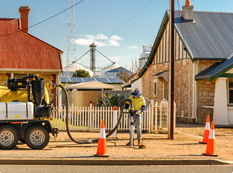Environmental protection
Environmental protection
Respect for the environment is built into our business.
We protect the local environment where we operate, with specialists who have knowledge of not just what we could do but why it matters. They ensure the good work we have already been doing in protecting our environment continues.
Building biodiversity
Biodiversity plays an important role in maintaining the health and vitality of ecosystems. For example, at our Millbrook reservoir reserve we have implemented a native vegetation offset project that is delivering remarkable results. Our innovative restoration blends both ‘top-down’ and ‘bottom-up’ revegetation techniques to establish tree and shrub habitat structure, as well as sowing a diverse understorey component to disperse throughout the site. These efforts have actively supported the establishment of a wide range of native plant and animal species.
The positive outcomes achieved at Millbrook has inspired us to explore further opportunities for biodiversity gains at our other reservoir reserves. By doing so, we aim to safeguard and nurture ecosystems for the benefit of our community and future generations.
Recycling and reuse
We are Australia’s second largest recycler of water, with one in every three litres of water being recycled. But we take it further – like taking water and wastewater treatment plant residual material and reusing it rather than sending it to landfill. Each year we collect and safely treat about 30,000 tonnes of organic biosolids this way, providing it free to local primary producers who use it for soil improvement.
Building environmental management into planning
Many projects have dedicated environmental management plans which outline strategies to ensure the local environment is protected.
Our specialists are involved in the planning process, contributing ideas for sustainable plantings for new projects to create native vegetation offsets or functioning ecosystems on retired grazing land. This determines the best ways to re-establish native vegetation that is disturbed or even improve it.
We factor in environmental impacts before commencing work and landscape around new infrastructure, such as pumping stations, with our specialists advising on botanical plants and land management.
Protecting ecosystems
We ensure that conservation and good environmental outcomes are front of mind during the length of any capital works project. An example of this is when we did a major upgrade of the Kangaroo Creek Reservoir:
- when it was drained, we salvaged the carp and provided them to the manufacturing sector to become fertiliser
- we salvaged and then re-used native seed-bearing topsoil and tree limbs and logs which had a high habitat value
- around 600 native orchids, representing 12 species including the purple cockatoo orchid and king spider orchid, were rescued during excavation works and replanted in another site. New seeds were also grown and planted, which has increased biodiversity in other water catchment lands we look after.
Meeting the growing needs of agribusiness
Through programs like the Northern Adelaide Irrigation Scheme, we support Adelaide’s horticulture and floriculture industries by providing a valuable source of climate independent treated wastewater for irrigation. Around 20 gigalitres of recycled water a year from the Bolivar Wastewater Treatment Plant also reach market gardeners through the Virginia Pipeline Scheme.
Catchment and land management
We manage a large amount of land across the state, particularly water catchment areas, working with the South Australian government, natural resources management groups and volunteers. Managing catchment areas is a key way to protect water quality and our water sources and conservation outcomes, and includes:
- improving the health of our ecosystems
- fire management to reducing bushfire risk and promote regeneration
- removing non-native plants and animals to prevent their spread
- revegetation.
Cement pipe management
We are working to decrease the cement pipes in our network that contain bonded, non-friable asbestos. Asbestos cement pipes are widely used for water supply throughout Australia and across the world.
The World Health Organisation and Australian Drinking Water Guidelines confirms that the presence of asbestos cement pipes within water networks does not pose a public health risk.
Major faults
Polkinghorns Rd
Arthurton
- 18/06/2020
Water Supply On
- 18/06/2020 03:05 PM - We are attending to an incident in Arthurton with no interruption to the water supply. The safety of our crews and customers comes first, and we always aim to minimise inconvenience by restoring services as quickly as we can. Reference Number WO: 07505663.
- See all major faults
Scheduled works
Spruance Rd
Elizabeth East
- 11/06/2021
Temporary Supply Interruption
- Estimated start time and water supply off: 15/06/2021 09:00 AM
Estimated restore time and water supply back on: 15/06/2021 04:00 PM
We’re improving your services and undertaking maintenance work in Elizabeth East. Sometimes our crews need to temporarily interrupt the water supply to our customers and/or manage traffic while they are working. Temporary traffic management may remain in place until reinstatement of the impacted road is complete. We always aim to minimise inconvenience by restoring services as safely and quickly as we can. - See all scheduled works









